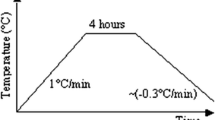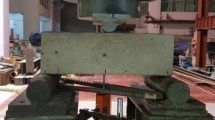Abstract
Polypropylene fibers are embedded to prevent reactive powder concrete (RPC) from spalling failure under high temperatures. This paper probes the influence of embedded fibers at various volumetric dosages on the thermomechanical properties of polypropylene-fibered reactive powder concrete (PPRPC) exposed to high temperatures up to 350 °C and on the spalling performance and characteristics up to 600 °C. The thermomechanical properties include the characteristic temperature for spalling, and residual strengths, such as the compressive strength, split tensile strength, and flexural tensile strength. A high-definition charge-coupled device camera and scanning electron microscope technology were employed to capture the spalling processes and to detect the microstructural changes in the materials with various fiber dosages. To understand and characterize the mechanism by which polypropylene fibers influence the thermal spalling of RPC, a numerical model to determine the moisture migration and vapor pressure transmission during spalling was developed in this paper. It showed that there was an optimal volumetric dosage of fibers to prevent PPRPC from explosive spalling. The relationships between the mechanical characteristics of PPRPC and the fiber dosages were derived based on experimental data.
摘要
聚丙烯纤维可用于改善活性粉末混凝土(RPC)的高温爆裂,本文实验研究了不同掺量聚丙烯纤维对活性粉末混凝土热物理力学性质以及高温爆裂特征的影响,测试并分析了聚丙烯RPC的抗压、劈裂和弯折强度随温度和纤维掺量的变化规律;利用自主研制的高温实验装置及高清摄像机观测了聚丙烯RPC高温爆裂的全过程,获取了起止温度、持续时间等爆裂特征。利用SEM分析了聚丙烯纤维熔化前后的微观结构变化及其对内部蒸汽压作用的影响,结合内部蒸汽压和含湿量的数值计算, 定量分析了RPC爆裂破坏的蒸汽压机理。实验发现:改善聚丙烯RPC高温力学性能和缓解其爆裂破坏的聚丙烯纤维最优掺量为0.9 %。






















Similar content being viewed by others
References
Bache HH (1981) Densified cement ultra-fine particle-based materials. In: Proceedings of the 2nd international conference on superplasticizers in Concrete. Ottawa
Richard P, Cheyrezy MH (1995) Composition of reactive powder concretes. Cem Concr Res 25:1501–1511
Richard P, Cheyrezy MH (1994) Reactive powder concretes with high ductility and 200–800 MPa compressive strength. ACI Spec Publ 144:507–518
Ju Y, Jia YD, Liu HB et al (2007) Mesomechanism of steel fiber reinforcement and toughening of reactive powder concrete. Sci China Tech Sci 50:815–832
Ju Y, Liu HB, Sheng GH et al (2010) Experimental study of dynamic mechanical properties of reactive powder concrete under high-strain-rate impacts. Sci China Tech Sci 53:2435–2449
Ju Y, Liu HB, Chen J et al (2009) Toughness and characterization of reactive powder concrete with ultra-high strength. Sci China Tech Sci 52:1000–1018
Peng GF, Kang YR, Huang YZ et al (2012) Experimental research on fire resistance of reactive powder concrete. Adv Mater Sci Eng 2012:1–6
Liu CT, Huang JS (2009) Fire performance of highly flowable reactive powder concrete. Constr Build Mater 23:2072–2079
Ju Y, Liu HB, Liu JH et al (2011) Investigation on thermophysical properties of reactive powder concrete. Sci China Tech Sci 54:3382–3403
Hager I, Zdeb T (2011) Influence of curing conditions on spalling behavior of reactive powder concretes. In: Proceedings of the 2nd international RILEM workshop on concrete spalling due to fire exposure. Delft, pp 377–383
Khoury GA (2000) Effect of fire on concrete and concrete structures. Prog Struct Eng Mater 2:429–447
Liu HB (2012) Experimental study on the mechanical properties and explosive spalling of reactive powder concrete exposed to high temperatures. PhD Thesis, Beijing: China University of Mining and Technology (in Chinese)
Bazant ZP, Thonguthai W (1979) Pore pressure in heated concrete walls: theoretical prediction. Mag Concr Res 31:67–76
Bazant ZP (1997) Analysis of pore pressure, thermal stresses and fractures in rapidly heated concrete. In: International workshop on fire performance of high-strength concrete. NIST, Gaithersburg, pp 155–164
Mindeguia J, Pimienta P, Noumowe A et al (2010) Temperature, pore pressure and mass variation of concrete subjected to high temperature-experimental and numerical discussion on spalling risk. Cem Concr Res 40:477–487
Kodur VKR (2000) Spalling in high strength concrete exposed to fire: concerns, causes, critical parameters and cures. ASCE Structures Congress, Philadelphia, pp 1–8
Matthias Z, David L, Roman L et al (2006) How do polypropylene fibres improve the spalling behavior of in situ concrete? Cem Concr Res 36:929–942
Kalifa P, Menneteau FD, Quenard D (2000) Spalling and pore pressure in HPC at high temperatures. Cem Concr Res 30:1915–1927
Consolazio GR, McVay MC, Rish JW (1997) Measurement and prediction of pore pressure in cement mortar subjected to elevated temperature. In: International workshop on fire performance of high-strength concrete. NIST, Gaithersburg, pp 125–148
Dougill JW (1972) Modes of failure of concrete panels exposed to high temperatures. Mag Concr Res 24:71–76
Fu Y, Li L (2010) Study on mechanism of thermal spalling in concrete exposed to elevated temperatures. Mater Struct 44:1–16
Kalifa P, Chene G (2001) High-temperature behavior of HPC with polypropylene fibres from spalling to micro-structure. Cem Concr Res 31:1487–1499
Phan LT (2008) Pore pressure and explosive spalling in concrete. Mater Struct 41:1623–1632
Ju Y, Liu HB, Tian KP et al (2013) An investigation on micro pore structures and the vapor pressure mechanism of explosive spalling of RPC exposed to high temperature. Sci China Tech Sci 56:458–470
Chan SYN, Peng GF, Anson M (1999) Fire behavior of high-performance concrete made with silica fume at various moisture contents. ACI Mater J 96:405–409
Peng GF (2000) Evaluation of fire damage to high performance concrete. PhD thesis, Hong Kong, The Hong Kong Polytechnic University
Mugume RB, Takashi H (2012) Effect of fibre type and geometry on maximum pore pressures in fibre-reinforced high strength concrete at elevated temperatures. Cem Concr Res 42:459–466
Bilodeau A, Kodur VKR, Hoff GC (2004) Optimization of the type and amount of polypropylene fibres for preventing the spalling of lightweight concrete subjected to hydrocarbon fire. Cem Concr Compos 26:163–174
Bangi MR, Horiguchi T (2011) Pore pressure development in hybrid fibre-reinforced high strength concrete at elevated temperatures. Cem Concr Res 41:1150–1156
Lennon T, Clayton N (1999) Fire test on high-grade concrete with polypropylene fibres. In: Proceedings of the 5th international symposium utilization of HSC/HPC. Sandefjord, pp 1200–1209
Suhaendi SL, Horiguchi T (2005) Fibre-reinforced high-strength concrete under elevated temperature: effect of fibres on residual properties. In: Proceedings of the 8th international symposium on fire safety science. Beijing, pp 271–278
Saka T (2009) Spalling potential of fire exposed structural concrete. In: Proceedings of the 1st international workshop on concrete spalling due to fire exposure. Leipzig
Khoury GA (2008) Polypropylene fibres in heated concrete, part 2: pressure relief mechanisms and modelling criteria. Mag Concr Res 60:189–204
Komonen J, Penttala V (2003) Effects of high temperature on the pore structure and strength of plain and polypropylene fiber reinforced cement pastes. Fire Technol 39:23–34
Noumowe A (2005) Mechanical properties and microstructure of high strength concrete containing polypropylene fibres exposed to temperatures up to 200 °C. Cem Concr Res 35:2192–2198
Suhaendi SL, Horiguchi T (2006) Effect of short fibers on residual permeability and mechanical properties of hybrid fibre reinforced high strength concrete after heat exposition. Cem Concr Res 36:1672–1678
Liu X, Ye G, Schutter GD et al (2008) On the mechanism of polypropylene fibres in preventing fire spalling in self-compacting and high-performance cement paste. Cem Concr Res 38:487–499
Lee JH, Sohn YS, Lee SH (2012) Fire resistance of hybrid fibre-reinforced, ultra-high-strength concrete columns with compressive strength from 120 to 200 MPa. Mag Concr Res 64:539–550
Han CG, Hwang YS, Yang SH et al (2005) Performance of spalling resistance of high performance concrete with polypropylene fiber contents and lateral confinement. Cem Concr Res 35:1747–1753
Gary RC, Michael CM (1998) Measurement and prediction of pore pressure in cement mortar subjected to elevated temperature. ACI Mater J 95:525–536
Aydin S, Yazici H, Baradan B (2008) High temperature resistance of normal strength and autoclaved high strength mortars incorporated polypropylene and steel fibers. Constr Build Mater 22:504–512
Zanni H, Cheyrezy M, Maret V et al (1996) Investigation of hydration and pozzolanic reaction in reactive powder concrete (RPC) using 29Si NMR. Cem Concr Res 26:93–100
Zheng W, Luo B, Wang Y (2014) Microstructure and mechanical properties of RPC containing PP fibres at elevated temperatures. Mag Concr Res 66:397–408
Tam C, Tam VW (2012) Microstructural behaviour of reactive powder concrete under different heating regimes. Mag Concr Res 64:259–267
Cheyrezy M, Maret V, Frouin L (1995) Microstructural analysis of RPC (reactive powder concrete). Cem Concr Res 25:1491–1500
Kumar AMU, Rao AU, Sabhahit N (2013) Reactive powder concrete properties with cement replacement using waste material. Int J Sci Eng Res 4:203–206
Nishida A, Yamazaki N, Inoue H (1995) Study on the properties of high strength concrete with short polypropylene fibre for spalling resistance. Shimizu Tech Res Bull 14:1–6
Chan YN, Luo X, Sun W (2000) Compressive strength and pore structure of high-performance concrete after exposure to high temperature up to 800 °C. Cem Concr Res 30:247–251
Poon CS, Shui ZH, Lam L (2004) Compressive behavior of fiber reinforced high-performance concrete subjected to elevated temperatures. Cem Concr Res 34:2215–2222
Ayudhya BIN (2011) Compressive and splitting tensile strength of autoclaved aerated concrete (AAC) containing perlite aggregate and polypropylene fiber subjected to high temperatures. Sonklanakarin J Sci Technol 33:555–563
Tian KP (2012) Experimental research on the explosive spalling phenomena and mechanism of reactive powder concrete at elevated temperature. MSc Thesis, Beijing, China University of Mining Technology (in Chinese)
Bazant ZP, Kaplan MF (1996) Concrete at high temperatures. Longman-Addison-Wesley, London
Ye G, Liu X, Schutter GD et al (2007) Influence of limestone powder used as filler in SCC on hydration and microstructure of cement pastes. Cem Concr Compos 29:94–102
Ye G, Liu X, Schutter GD et al (2007) Phase distribution and microstructural changes of self-compacting cement paste at elevated temperature. Cem Concr Res 37:978–987
Harmathy TZ (1965) Effect of moisture on the fire endurance of building elements, Philadelphia. ASTM Spec Tech Publ 385:74–95
Smith P (1978) Chapter 25: resistance to high temperature, in significance of test and properties of concrete and concrete-making materials. ASTM International, West Conshohocken
Bazant ZP, Chern JC (1981) Finite element program for moisture and heat transfer in heated concrete. Nucl Eng Des 68:61–70
Selih J, Sousa ACM, Bremner TW (1994) Moisture and heat flow in concrete walls exposed to fire. J Eng Mech 120:2028–2043
Kodres CA (1996) Moisture-induced pressures in concrete airfield pavements. J Mater Civil Eng 8:41–50
Ahmed GN, Hurst JP (1997) Coupled heat and mass transport phenomena in siliceous aggregate concrete slabs subjected to fire. Fire Mater 21:161–168
Ju Y, Wang JB, Gao F et al (2014) Lattice-Boltzmann simulation of microscale CH4 flow in porous rock subject to force-induced deformation. Chin Sci Bull 59:3292–3303
Gawin D, Majorana CE, Schrefler BA (1999) Numerical analysis of hygro-thermal behavior and damage of concrete at high temperature. Mech Cohes Frict Mater 4:37–74
Van D, Heijden GHA, Van Bijnen RMW et al (2007) Moisture transport in heated concrete, as studied by NMR, and its consequences for fire spalling. Cem Concr Res 37:894–901
Khoylou N, England G (1997) The effect of elevated temperatures on the moisture migration and spalling behavior of high-strength and normal concretes. ACI Spec Publ 167:263–290
Noguchi T, Kanematsu M, Ko JW et al (2010) Heat and moisture movement and explosive spalling in concrete under fire environment. In: Proceedings of the 6th international conference on concrete under severe conditions: environment and loading. Yucatan
Acknowledgments
This work was supported by the National Natural Science Foundation of China (51125017 and 50974125), Research Fund for Doctoral Programs of Chinese Ministry of Education (20110023110015), the Fund for Creative Research & Development Group Program of Jiangsu Province, and the Priority Academic Program Development of Jiangsu Higher Education Institutions (PAPD).
Author information
Authors and Affiliations
Corresponding author
Conflict of interest
Conflict of interest
The authors declare that they have no conflict of interest.
About this article
Cite this article
Ju, Y., Wang, L., Liu, H. et al. An experimental investigation of the thermal spalling of polypropylene-fibered reactive powder concrete exposed to elevated temperatures. Sci. Bull. 60, 2022–2040 (2015). https://doi.org/10.1007/s11434-015-0939-0
Received:
Accepted:
Published:
Issue Date:
DOI: https://doi.org/10.1007/s11434-015-0939-0
Keywords
- Polypropylene reactive powder concrete (PPRPC)
- Thermal spalling
- Vapor pressure mechanism
- Polypropylene fibers
- Elevated temperatures




